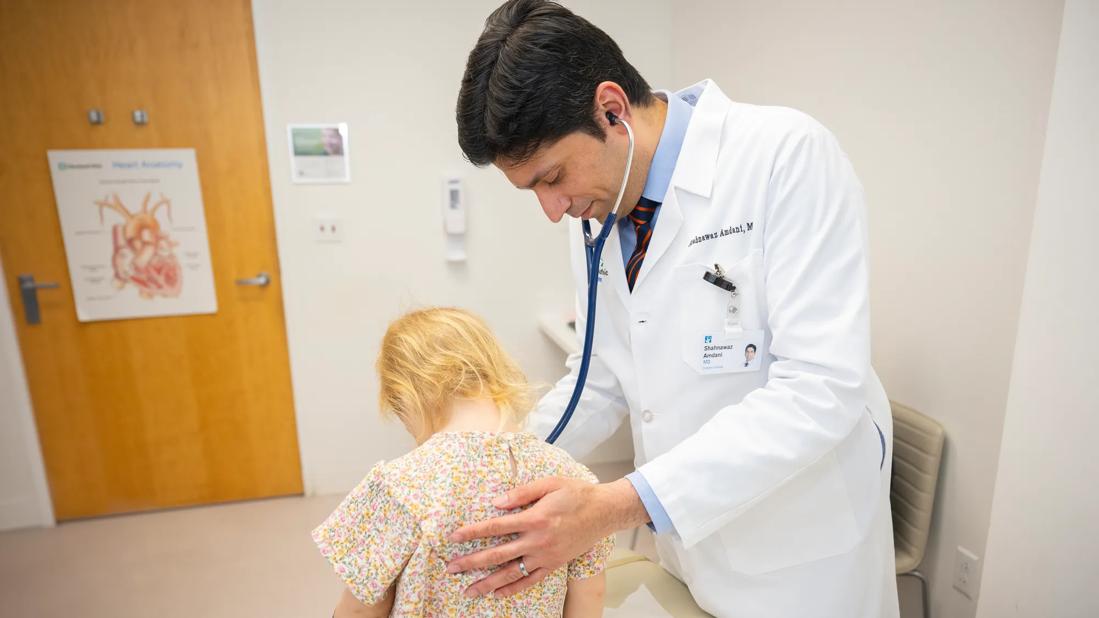Authors find the higher death rates in children compared with adults with heart failure 'disturbing'

The first comprehensive assessment of pediatric heart failure (HF) in U.S. children, published in the Journal of the American College of Cardiology, found that while the burden of HF is much lower in children than in adults across the healthcare system, children with HF have longer hospital stays, utilize more resources and are more likely to die in the emergency department (ED) and hospital than adults with HF.
Advertisement
Cleveland Clinic is a non-profit academic medical center. Advertising on our site helps support our mission. We do not endorse non-Cleveland Clinic products or services. Policy
First author Shahnawaz Amdani, MD, a pediatric heart failure and transplant cardiologist at Cleveland Clinic Children’s, says the study is a “call to arms.”
“It’s just not acceptable in this day and age. We need to figure out how to keep these kids out of the ED and hospital, because once they get to the ED or need to be hospitalized, it may be too late to intervene,” he says.
HF is a well-known, well-studied entity in adults. According to the American Heart Association’s Heart Disease and Stroke Statistics 2022 Update, an estimated 6.0 million U.S. residents age 20 and older are currently living with the condition. By the year 2030, this number is expected to rise above 8 million, with a projected cost of $160 billion.
The high prevalence of HF and staggering cost of treating the condition have spawned aggressive research that is paying off by improving understanding of the course of HF and leading to the development of medications that have lowered HF-related hospitalization rates in adults.
Dr. Amdani and colleagues sought to obtain an equivalent understanding of pediatric HF in this country. “We felt that knowing the trends, risk factors, overall burden of disease and what causes these young patients to die would allow us to take specific measures to reduce ED visits, hospitalizations and mortality rates in this very special population,” he says.
To fill the knowledge gap, the researchers mined four databases: the National Emergency Department Sample (NEDS) for outcomes of and charges associated with ED visits; the Kids’ Inpatient Database (KID) and National Inpatient Sample (NIS) for hospitalizations, and associated charges and outcomes; and the National Vital Statistics System for deaths.
Advertisement
Data on children age 17 and under with HF were obtained for 2012 and 2016. Where HF was listed as a primary diagnosis or underlying cause of death, the event was classified as primary HF. When HF was listed as a comorbid diagnosis or contributing cause of death, the event was listed as comorbid HF.
To obtain accurate figures without counting patients twice, the researchers utilized a unique technique: When using the NEDS database, patients who came to the ED and were subsequently hospitalized, transferred to another hospital or died were excluded. When using the KID database, hospitalizations that were elective or resulted in a hospital transfer or death were excluded. This enabled the researchers to identify unique ED visits, hospitalizations and deaths.
In addition to finding that children with HF have longer hospital stays, utilize more per-patient resources and are more likely to die in the emergency department (ED) and hospital than adults with HF, the study revealed that:
As medical knowledge advances, pediatric patients with multiple comorbidities are living longer. However, these children are hospitalized frequently, often stay in the hospital longer and require multiple interventions while hospitalized, thereby incurring high costs from the variety of sophisticated services they require.
Advertisement
“We need to find ways to prevent HF in the congenital heart disease population, because we know that once these patients develop HF, they are more likely to have repeated ED visits and hospitalizations and need advanced therapies such as ventricular assist devices or transplantation, or die,” says Dr. Amdani. “However, congenital heart disease is a big umbrella. If we could identify which types of congenital heart disease are most likely to result in advanced HF, we could follow these patients more closely and target appropriate interventions.
“In fact, this will be the focus of our next study,” he says.
The outlook for pediatric patients with cardiomyopathies is brighter, since they are more effectively managed today with evidence-based HF medications than in the past. But the dearth of medications for pediatric HF remains a sore point with Dr. Amdani.
“We have only one FDA-approved medication for pediatric HF: sacubitril-valsartan (Entresto®). The others are borrowed from the adult experience and have not been proven to be beneficial yet in randomized clinical trials conducted in children,” he says. “Future medications need to be geared toward children with HF, so that we can be as successful as our colleagues are in managing HF in adults.”
Advertisement
Advertisement

Integrated care model reduces length of stay, improves outpatient pain management

A closer look at the impact on procedures and patient outcomes

Experts advise thorough assessment of right ventricle and reinforcement of tricuspid valve

Study also finds that 26% of children with cancer have mutations in DNA repair genes

A closer look at current uses and future opportunities

Experts are challenging the one-size-fits-all paradigm

Quality improvement project addresses unplanned extubation

Cardiac imaging substudy is the latest paper originating from the VANISH trial